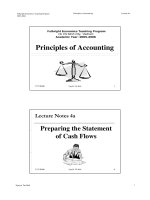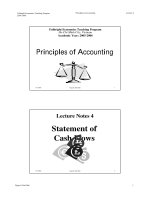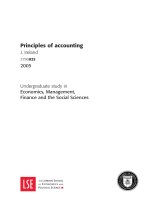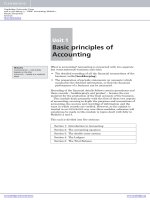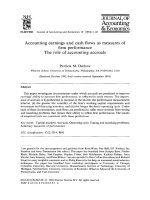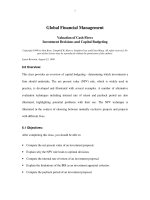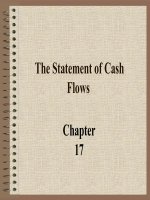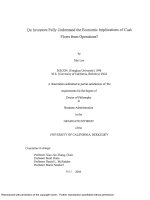Principles of Accounting- Statement of Cash Flows
Bạn đang xem bản rút gọn của tài liệu. Xem và tải ngay bản đầy đủ của tài liệu tại đây (134.23 KB, 24 trang )
Nguyen Tan Binh
1
Fulbright Economics Teaching Program
2005-2006
Principles of accounting Lecture 4
7/17/2006 Nguyễn Tấn Bình 1
Principles of Accounting
Fulbright Economics Teaching Program
Ho Chi Minh City, Vietnam
Academic Year: 2005-2006
7/17/2006 Nguyễn Tấn Bình 2
Lecture Notes 4
Statement of
Cash Flows
Nguyen Tan Binh
2
Fulbright Economics Teaching Program
2005-2006
Principles of accounting Lecture 4
7/17/2006 Nguyễn Tấn Bình 3
The main objective of
the statement of cash flows
• Shows the relationship between the Net
Income and Net Cash Flow
• Explains how cash is generated and used
during a business period
• Evaluates the ability to pay debt in time
• This information is very useful to decision
makers (managers, lenders, shareholders…)
in forecasting the future cash flows
7/17/2006 Nguyễn Tấn Bình 4
The necessity of
the statement of cash flows
Additionally provides a lot of important information
that the balance sheet and the income statement
cannot to provide:
• The balance sheet only reflects the values and the
sources of assets at a certain date (a point of time)
9 How to know how much the firm has disbursed for
purchases (or collected from liquidations) of fixed
assets during a business period?
9 How to know how much the firm has borrowed (or
paid back) during a business period?
Nguyen Tan Binh
3
Fulbright Economics Teaching Program
2005-2006
Principles of accounting Lecture 4
7/17/2006 Nguyễn Tấn Bình 5
The necessity of
the statement of cash flows
Additionally provides a lot of important information that the
balance sheet and the income statement fail to provide
:
• The income statement is made on the accrual, not
the cash, basis of accounting
9 Why does a firm show profit but have no cash, and vice
versa?
9 How to explain changes (increases or decreases) in cash
balance from the beginning to the end of the business
period?
7/17/2006 Nguyễn Tấn Bình 6
What is called “cash” in the
statement of cash flows
• Cash, bank deposits, floats, and cash
equivalent securities
• Cash equivalent securities include
– Marketable securities with high liquidity
– Easy to be transferred into cash
Nguyen Tan Binh
4
Fulbright Economics Teaching Program
2005-2006
Principles of accounting Lecture 4
7/17/2006 Nguyễn Tấn Bình 7
Classification of cash flows
A firm of any form or any size has 3 types of
activities:
1. Operating
2. Investing
3. Financing
The statement of cash flows reflects three
cash flows from the three above activities
7/17/2006 Nguyễn Tấn Bình 8
Cash flow from operating
• Disbursement flows into and receipt flows from
the main operating activity of the firm
• There are two methods to calculate the cash flow
from operating activity:
–Direct method
–Indirect method
Nguyen Tan Binh
5
Fulbright Economics Teaching Program
2005-2006
Principles of accounting Lecture 4
7/17/2006 Nguyễn Tấn Bình 9
Cash flow from operating
Receipt flows (inflows) include:
– Collections from customers
– Interest receipt, receipt from other
operations
– Dividend receipt (from
investments in other companies)
7/17/2006 Nguyễn Tấn Bình 10
Cash flow from operating
Disbursement flows (outflows) include
– Payment to suppliers
– Interest, tax payments
– Salary payment
– Payment to other operations
P
a
y
t
o
t
h
e
o
r
d
e
r
o
f
Nguyen Tan Binh
6
Fulbright Economics Teaching Program
2005-2006
Principles of accounting Lecture 4
7/17/2006 Nguyễn Tấn Bình 11
Cash flows from investing and
financing
• Only one method to prepare
cash flows from investing and
financing: the direct method
•Shows the actual
disbursement and receipt
flows
7/17/2006 Nguyễn Tấn Bình 12
Cash flow from investing
• Disbursement and receipt
flows for purchases and
sales of fixed assets,
investments, and investment
recovery
Nguyen Tan Binh
7
Fulbright Economics Teaching Program
2005-2006
Principles of accounting Lecture 4
7/17/2006 Nguyễn Tấn Bình 13
Cash flow from investing
• Receipt flows (inflows) include
– Liquidations of fixed assets
– Sales of marketable
securities
– Recovery of investment or
lending
7/17/2006 Nguyễn Tấn Bình 14
• Disbursement flows (outflows) include
– Purchases of fixed assets
– Purchases of marketable
securities
– Lending or capital
contribution to other
companies
Cash flow from investing
Nguyen Tan Binh
8
Fulbright Economics Teaching Program
2005-2006
Principles of accounting Lecture 4
7/17/2006 Nguyễn Tấn Bình 15
• Disbursement flows into and
receipt flows from financing
activity (capital mobilization)
for the firm’s operations
• Funds raised from owners and
lenders
Cash flow from financing
7/17/2006 Nguyễn Tấn Bình 16
• Receipt flows (inflows) include
– Stock issue
– Corporate bond issue
– Bank loans
Cash flow from financing
Nguyen Tan Binh
9
Fulbright Economics Teaching Program
2005-2006
Principles of accounting Lecture 4
7/17/2006 Nguyễn Tấn Bình 17
• Disbursement flows (outflows) include
– Repurchases of stock (treasury
stock)
– Recall or payment of corporate
bond
– Debt payment
– Dividend payment
Cash flow from financing
7/17/2006 Nguyễn Tấn Bình 18
Non-cash investing and financing
activities
Example:
– Debt-equity conversion
– Purchases and sales of fixed assets on
credit
• These activities do not generate cash flows, hence,
are not shown on the statement of cash flows
• However, the endnotes to the statement of cash
flows or a separate statement is prepared to explain
their changes on the balance sheet

